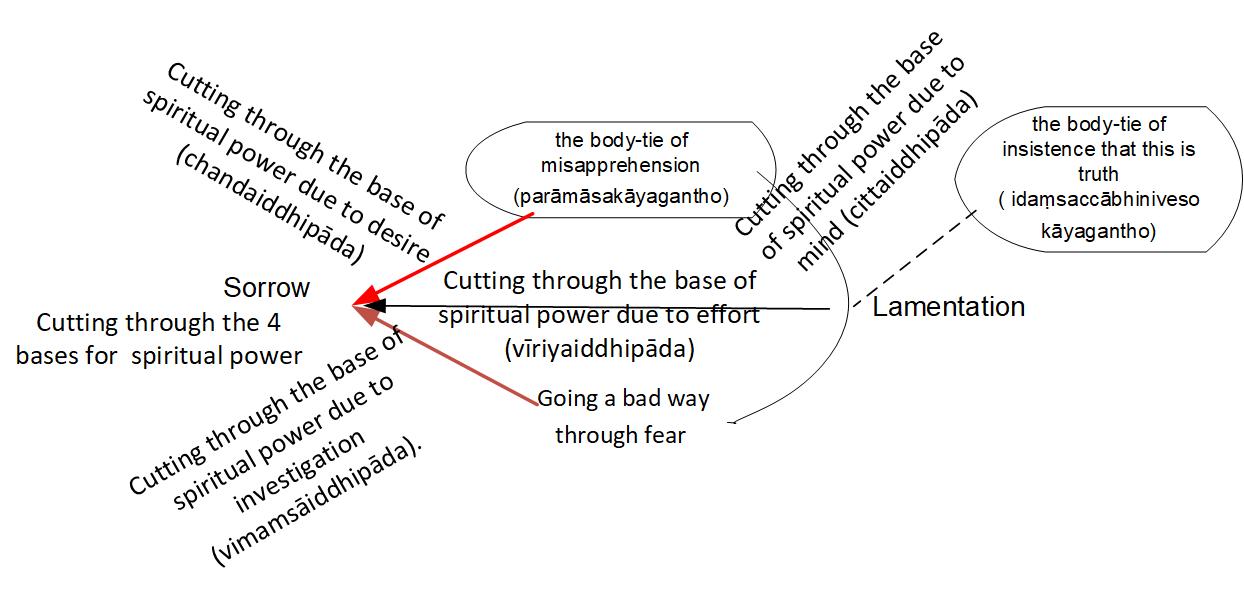The Noble Council of Akanittha Brahma Realm was remembered with faith.
I repeated the 24/01/2025 Nibbāna meditation.(*1) There, if the path arising due to sorrow (soka) occurs, the progression from 7.6 to 8.2 cannot be stopped. The ‘decision to make volitional formations’ (sankhāra adhimokkha) cannot be prevented. By knowing to this extent, it was learned that, only if the ‘investigation’ (vīmaṃsā) is powerful enough to prevent the path formed due to ‘sorrow,’ (soka), then it is possible to stop the arising of ‘with volitional formations as condition, consciousness’ (saṅkhārapaccayā viññāṇaṃ), that is, stopping at that point A itself, is possible.
In this meditation, having marked the taint of existence (bhava āsava) near sorrow, I examined further. At this point, my mind was drawn to the diagram that was learned on 14/04/2015 Cattaro iddhipāda (four bases of spiritual power) meditation.

The Budu Piya mentioned that when there is base of spiritual power due to desire (chanda iddhipāda), it comprises two aspects of dhamma: the removal of volitional formations (sankhāra) and not sorrowing (soka). That is so. When one abandons volitional formations (sankhāra), such as letting go of jobs and businesses, the dhamma associated with sorrow (soka) that arise due to volitional formations (sankhāra) also subside. Whatever misapprehensions occurred due to volitional formations (sankhāra), whatever misapprehensions arose due to chicken farms, those dhamma subside. Moreover, when examining the example of chicken farms, the values of conceit that arose because of them also subside.
We know that when the base of spiritual power due to mind (citta iddhipāda) exists, it removes the momentum of volitional formations (sankhāra). Furthermore, it includes showing that whatever notion called ‘pleasure’ there is, it does not arise through volitional formations (saṅkhāra). That is so. The fact that suffering (dukkha) is included in thought (saṅkappo) was examined during the 10/01/2025 Nibbāna meditation. Examine the thought (saṅkappo) there. The Four Noble Truths are included within it. We know that the dhamma related to effort (viriya) were helpful for this. Use the principle that was used in examining the mental fixity (appanā) doctrine where 'the mind settles into studying the Sutta Pitaka.' The Budu Piya said that only if that effort (viriya) is well-established, one will not proceed from lamentation (parideva) to sorrow (soka). To that extent, it must be nourished by the Four Noble Truths.
What remains are the form-values on the conceit path. This can be marked from the going a bad way through fear (bhayā agatigamanaṃ) to sorrow (soka). This is connected with the taint of existence (bhava āsava). We know that the taint of existence (bhava āsava) is marked near sorrow (soka). Whatever volitional formation (sankhāra) was done before, flowing of the resulting conceit values should be brought to a stop. How does investigation (vīmaṃsā) help with this? Whatever understanding of dependently arising (paṭiccasamuppanna) there is, it shows that all volitional formations (sankhāra) lead to suffering. That is, it shows that consciousness that arise with volitional formations as condition, is suffering.
That is the meditation.
To add a little more to this,
When doing this meditation, the mind becomes very expansive while all four bases of spiritual power (cattāro iddhipāda) are well-established. All parts of the face and head are felt in the same way, with no discernible difference. Whether seeing the mind-made body's eye, seeing small creatures like ants on the ground, even going into cessation (nirodha), the mind remained in a state where no difference could be found due to any of these. There is not even a single appreciation of any doctrine there.
That's what needs to be added.
(*1) There, we used the diagram given in the Nibbana meditation of 14/07/2015.